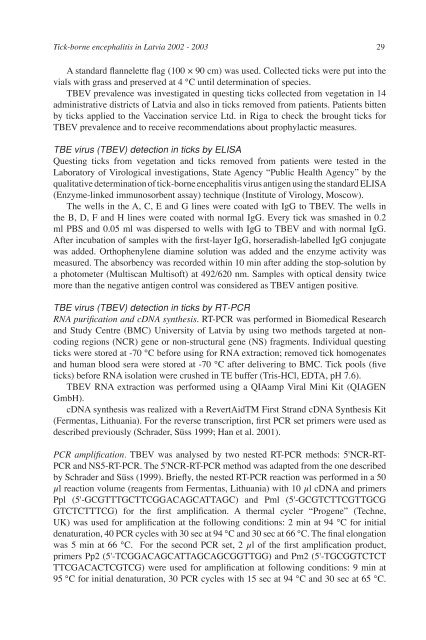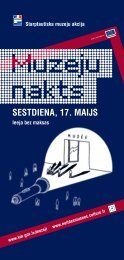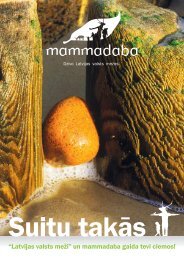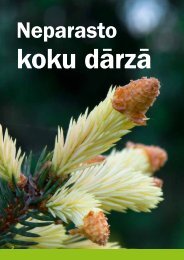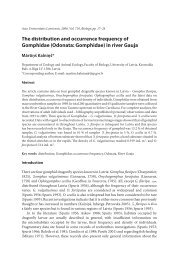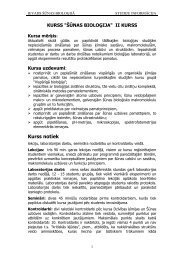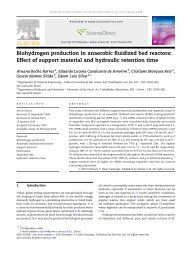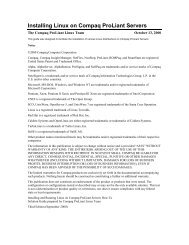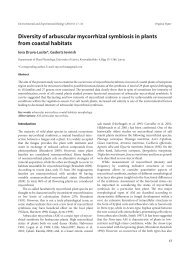Full Text (PDF) - Latvijas UniversitÄte
Full Text (PDF) - Latvijas UniversitÄte
Full Text (PDF) - Latvijas UniversitÄte
You also want an ePaper? Increase the reach of your titles
YUMPU automatically turns print PDFs into web optimized ePapers that Google loves.
Tick-borne encephalitis in Latvia 2002 - 2003 29<br />
A standard flannelette flag (100 × 90 cm) was used. Collected ticks were put into the<br />
vials with grass and preserved at 4 °C until determination of species.<br />
TBEV prevalence was investigated in questing ticks collected from vegetation in 14<br />
administrative districts of Latvia and also in ticks removed from patients. Patients bitten<br />
by ticks applied to the Vaccination service Ltd. in Riga to check the brought ticks for<br />
TBEV prevalence and to receive recommendations about prophylactic measures.<br />
TBE virus (TBEV) detection in ticks by ELISA<br />
Questing ticks from vegetation and ticks removed from patients were tested in the<br />
Laboratory of Virological investigations, State Agency “Public Health Agency” by the<br />
qualitative determination of tick-borne encephalitis virus antigen using the standard ELISA<br />
(Enzyme-linked immunosorbent assay) technique (Institute of Virology, Moscow).<br />
The wells in the A, C, E and G lines were coated with IgG to TBEV. The wells in<br />
the B, D, F and H lines were coated with normal IgG. Every tick was smashed in 0.2<br />
ml PBS and 0.05 ml was dispersed to wells with IgG to TBEV and with normal IgG.<br />
After incubation of samples with the first-layer IgG, horseradish-labelled IgG conjugate<br />
was added. Orthophenylene diamine solution was added and the enzyme activity was<br />
measured. The absorbency was recorded within 10 min after adding the stop-solution by<br />
a photometer (Multiscan Multisoft) at 492/620 nm. Samples with optical density twice<br />
more than the negative antigen control was considered as TBEV antigen positive.<br />
TBE virus (TBEV) detection in ticks by RT-PCR<br />
RNA purifi cation and cDNA synthesis. RT-PCR was performed in Biomedical Research<br />
and Study Centre (BMC) University of Latvia by using two methods targeted at noncoding<br />
regions (NCR) gene or non-structural gene (NS) fragments. Individual questing<br />
ticks were stored at -70 °C before using for RNA extraction; removed tick homogenates<br />
and human blood sera were stored at -70 °C after delivering to BMC. Tick pools (five<br />
ticks) before RNA isolation were crushed in TE buffer (Tris-HCl, EDTA, pH 7.6).<br />
TBEV RNA extraction was performed using a QIAamp Viral Mini Kit (QIAGEN<br />
GmbH).<br />
cDNA synthesis was realized with a RevertAidTM First Strand cDNA Synthesis Kit<br />
(Fermentas, Lithuania). For the reverse transcription, first PCR set primers were used as<br />
described previously (Schrader, Süss 1999; Han et al. 2001).<br />
PCR amplifi cation. TBEV was analysed by two nested RT-PCR methods: 5'NCR-RT-<br />
PCR and NS5-RT-PCR. The 5'NCR-RT-PCR method was adapted from the one described<br />
by Schrader and Süss (1999). Briefly, the nested RT-PCR reaction was performed in a 50<br />
µl reaction volume (reagents from Fermentas, Lithuania) with 10 µl cDNA and primers<br />
Ppl (5'-GCGTTTGCTTCGGACAGCATTAGC) and Pml (5'-GCGTCTTCGTTGCG<br />
GTCTCTTTCG) for the first amplification. A thermal cycler “Progene” (Techne,<br />
UK) was used for amplification at the following conditions: 2 min at 94 °C for initial<br />
denaturation, 40 PCR cycles with 30 sec at 94 °C and 30 sec at 66 °C. The final elongation<br />
was 5 min at 66 °C. For the second PCR set, 2 µl of the first amplification product,<br />
primers Pp2 (5'-TCGGACAGCATTAGCAGCGGTTGG) and Pm2 (5'-TGCGGTCTCT<br />
TTCGACACTCGTCG) were used for amplification at following conditions: 9 min at<br />
95 °C for initial denaturation, 30 PCR cycles with 15 sec at 94 °C and 30 sec at 65 °C.


